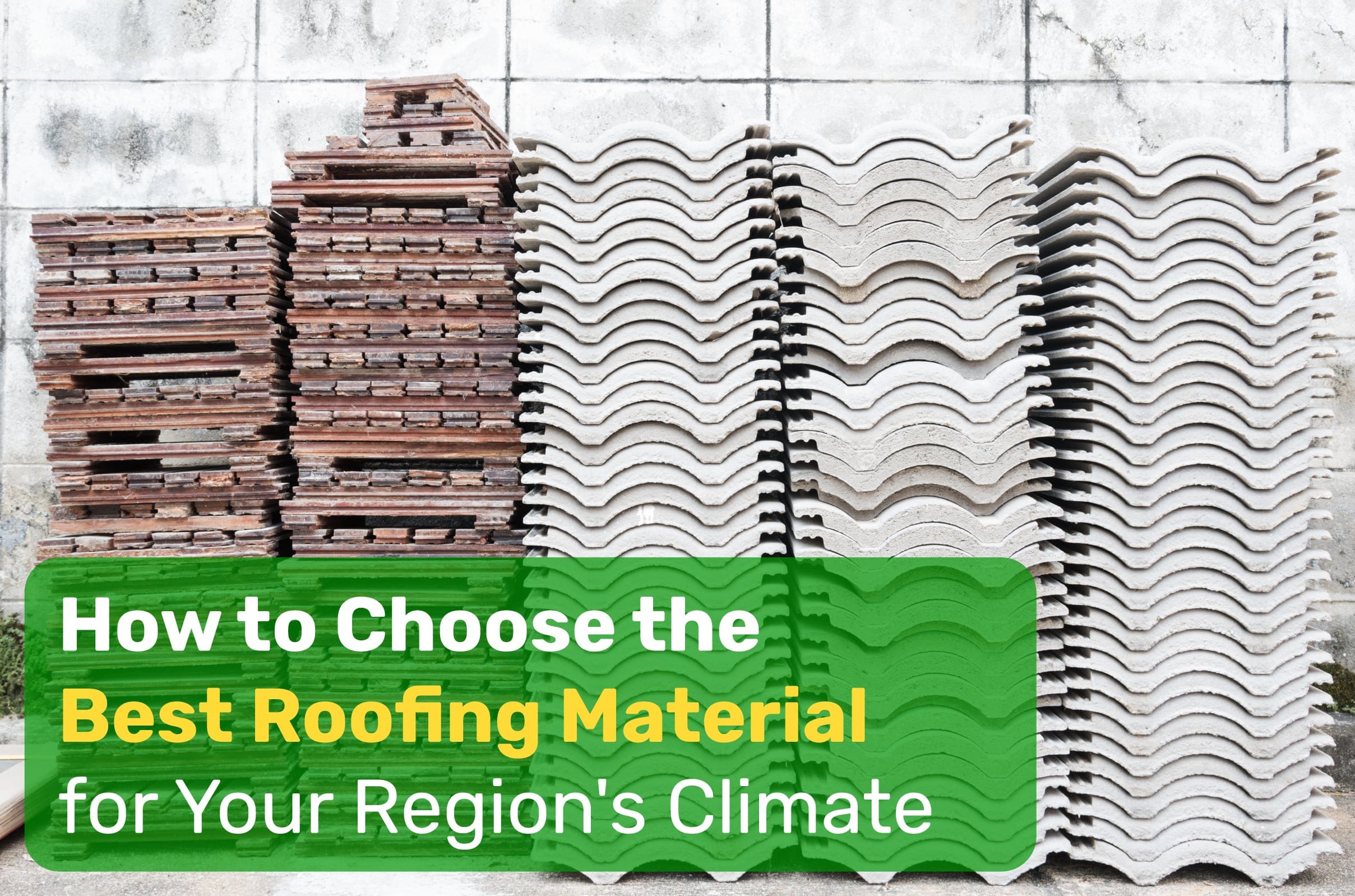Introduction
Roofing materials are a critical aspect of your home’s construction, providing protection and aesthetic appeal to your property. The selection of the right roofing material must consider the weather and climatic conditions of the region you live in. The climate can affect the lifespan and durability of your roof, leading to costly repairs and replacements down the road if you choose the wrong material. In this article, we’ll explore the considerations for roofing material selection based on the climate conditions of your region. We’ll discuss the ideal roofing materials for regions with heavy snow and ice loads, high rainfall, coastal regions, and hot and sunny climates. For example, metal roofs are an excellent option for heavy snow and ice load regions because of their durability, lightweight, water resistance, and energy efficiency. Tile roofs are a popular option for coastal regions as they are highly resistant to water and harsh coastal climate conditions. Asphalt shingles and wood shakes are ideal for areas with high rainfall because of their moisture resistance and affordability. By understanding the climate considerations for roofing material selection, you can make an informed decision that provides long-lasting protection for your home.
- Climate considerations for roofing material selection.
The climate of the region in which you live should be the primary factor you consider when selecting a roofing material for your home. The weather conditions in your area can significantly impact the lifespan and durability of your roof, and choosing the right material can help you avoid costly repairs or replacements down the line.
The first thing you should consider is the amount of rainfall your area typically receives. For regions with high levels of rainfall, such as the Pacific Northwest, you’ll want a roofing material that can resist moisture and prevent leaks. Asphalt shingles are a popular choice in such areas, as they are affordable and have excellent water resistance.
If you live in a hot and sunny climate, you may want to choose a roofing material that can reflect sunlight and reduce heat absorption. Metal roofs, which are made of reflective materials, are an excellent option for such regions. They can help keep your home cool and reduce your energy costs.
Areas that experience heavy snowfall or ice loads require roofing materials that can withstand the weight and pressure. Metal roofs are a durable and long-lasting option that can handle the weight of snow and ice. They also have excellent water resistance, making them an ideal choice for regions with frequent snow or ice.
Wood shakes are a good choice for areas with high humidity or where there’s a lot of rainfall, as they can resist rot and decay. They’re also a great option for homes with a rustic or traditional style. However, they may not be suitable for areas prone to wildfires, so you’ll need to consider your region’s fire risk.
Tile roofs are a great option for coastal regions, as they are resistant to moisture and have no seams or nail holes that can allow water to penetrate the surface. They’re also durable and long-lasting, making them a great investment for homeowners in such areas.
- Metal roofs for heavy snow and ice loads.
When choosing a roofing material for regions with heavy snow and ice loads, it’s essential to consider a material that can handle the weight and pressure. Metal roofs are an excellent option for such regions, as they are incredibly durable and long-lasting, making them a great investment for homeowners in areas prone to heavy snow and ice.
Metal roofs are made of steel, aluminum, copper, or other materials that are highly resistant to impact and damage. They can withstand the weight of heavy snow and ice loads, making them a perfect choice for homes in regions with frequent snowfall.
One of the primary benefits of metal roofs in heavy snow and ice load areas is their water resistance. When snow and ice melt, it can result in significant water damage if your roofing material cannot handle the excess water. Metal roofs are highly resistant to water, which means that they can help prevent leaks and water damage caused by melting snow and ice.
Metal roofs are also easy to install, which can reduce the cost and time of installation. They come in large panels or shingles, which makes them quick and straightforward to install. Additionally, metal roofs are lightweight, which means they put less stress on the structure of your home, reducing the risk of damage.
Finally, metal roofs are an excellent option for those who want to reduce their energy costs. Metal roofs are highly reflective, which means they can help keep your home cool in the summer months, reducing the need for air conditioning. They also retain heat in the winter months, reducing your heating costs.
- Moisture-resistant roofing for rainy climates.
For regions with high levels of rainfall, choosing a moisture-resistant roofing material is crucial to prevent leaks and water damage to your home. Rainy climates can lead to a buildup of moisture in roofing materials, resulting in mold and mildew growth that can be costly and time-consuming to remove. In this context, selecting the right roofing material is vital to keep your home dry and safe.
One of the most popular choices for moisture-resistant roofing materials in rainy climates is asphalt shingles. These shingles are durable, easy to install, and highly resistant to water, making them ideal for areas that experience frequent rainfall. Additionally, asphalt shingles are affordable and come in a range of colors and styles, which makes them an attractive choice for homeowners.
Metal roofing is another excellent option for rainy climates, as it’s highly resistant to moisture and water damage. Metal roofs are also highly durable and long-lasting, making them an excellent investment for homeowners looking for a roofing material that can withstand heavy rain and moisture.
If you prefer a more natural look, wood shakes are an excellent option for high-moisture areas. These shakes are made from materials that resist rot and decay, making them highly resistant to moisture. They are also an attractive option that can add warmth and character to your home’s exterior.
Tile roofs are another popular choice for rainy climates, as they are highly resistant to moisture and water damage. Unlike some other roofing materials, tiles don’t absorb water, which can help prevent mold and mildew growth. They’re also highly durable and long-lasting, making them a great investment for homeowners in regions with heavy rainfall.
- Tile roofs for coastal regions.
Coastal regions are notorious for their harsh weather conditions, including strong winds and high levels of moisture. As such, it’s crucial to select a roofing material that can withstand the saltwater, wind, and rain. Tile roofs are an excellent option for coastal regions because they’re highly durable and can protect your home from the harsh coastal climate.
One of the primary benefits of tile roofs in coastal regions is their high level of water resistance. Saltwater can cause significant damage to many roofing materials, but tile roofs are highly resistant to water, making them an ideal choice for coastal homes. Additionally, tile roofs don’t absorb water, which means they don’t allow mold or mildew to grow, making them an excellent choice for areas with high levels of moisture.
Another benefit of tile roofs is their durability. Tiles are made from materials such as clay or concrete, which are highly resistant to impact and damage caused by wind or other environmental factors. This makes tile roofs an excellent investment for homeowners in coastal regions who want a long-lasting roofing material.
Tile roofs are also highly energy-efficient. They have natural insulating properties that can help keep your home cool in the summer and warm in the winter. This can lead to lower energy bills and a more comfortable living environment throughout the year.
Finally, tile roofs are an attractive option for homeowners in coastal regions. They come in a range of colors and styles, which can complement your home’s exterior and add to its curb appeal. Tile roofs can also increase the value of your home, making them a wise investment for coastal homeowners.
- Locational and climatic factors in choosing the best roof.
When choosing a roofing material, it’s essential to consider the location of your home and the climate in your region. Different types of roofing materials are better suited to different climates, so it’s important to choose a material that can withstand the weather conditions in your area.
If you live in an area with high levels of precipitation, such as the Pacific Northwest or the Southeast, it’s important to choose a roofing material that is moisture-resistant. Materials like wood shakes and asphalt shingles can absorb moisture, which can lead to mold and mildew growth. Metal roofs, on the other hand, are a good option for areas with heavy snowfall and ice loads.
In areas with high winds, such as coastal regions and tornado-prone areas, it’s important to choose a roofing material that can withstand strong gusts. Metal roofs and tile roofs are both good options, as they are highly durable and resistant to impact.
The amount of sunlight that your region receives can also impact your roofing material selection. In hot and sunny areas, such as the Southwest, it’s important to choose a roofing material that can reflect heat and UV rays, such as metal roofs or shingles with a reflective coating. This can help keep your home cool and reduce your energy bills.
Conclusion
In conclusion, choosing the right roofing material is a critical aspect of your home’s construction. The climate and weather conditions of your region must be the primary consideration when selecting a roofing material to ensure long-lasting protection for your home. The ideal roofing material will depend on factors such as the amount of rainfall, temperature, and weather conditions of your region. Metal roofs are a great option for regions with heavy snow and ice loads, while tile roofs are an excellent choice for coastal regions. Asphalt shingles and wood shakes are suitable for areas with high rainfall. By understanding the climate considerations for roofing material selection, you can make an informed decision that meets the needs of your home and provides protection against costly repairs and replacements in the future.



